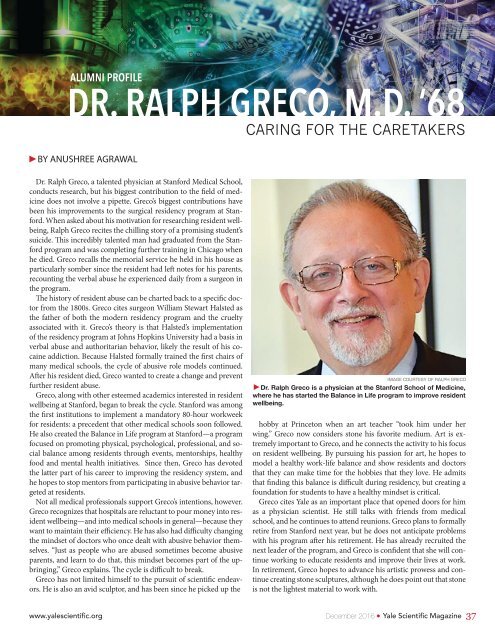YSM Issue 90.1
You also want an ePaper? Increase the reach of your titles
YUMPU automatically turns print PDFs into web optimized ePapers that Google loves.
ALUMNI PROFILE<br />
DR. RALPH GRECO, M.D. ‘68<br />
CARING FOR THE CARETAKERS<br />
►BY ANUSHREE AGRAWAL<br />
Dr. Ralph Greco, a talented physician at Stanford Medical School,<br />
conducts research, but his biggest contribution to the field of medicine<br />
does not involve a pipette. Greco’s biggest contributions have<br />
been his improvements to the surgical residency program at Stanford.<br />
When asked about his motivation for researching resident wellbeing,<br />
Ralph Greco recites the chilling story of a promising student’s<br />
suicide. This incredibly talented man had graduated from the Stanford<br />
program and was completing further training in Chicago when<br />
he died. Greco recalls the memorial service he held in his house as<br />
particularly somber since the resident had left notes for his parents,<br />
recounting the verbal abuse he experienced daily from a surgeon in<br />
the program.<br />
The history of resident abuse can be charted back to a specific doctor<br />
from the 1800s. Greco cites surgeon William Stewart Halsted as<br />
the father of both the modern residency program and the cruelty<br />
associated with it. Greco’s theory is that Halsted’s implementation<br />
of the residency program at Johns Hopkins University had a basis in<br />
verbal abuse and authoritarian behavior, likely the result of his cocaine<br />
addiction. Because Halsted formally trained the first chairs of<br />
many medical schools, the cycle of abusive role models continued.<br />
After his resident died, Greco wanted to create a change and prevent<br />
further resident abuse.<br />
Greco, along with other esteemed academics interested in resident<br />
wellbeing at Stanford, began to break the cycle. Stanford was among<br />
the first institutions to implement a mandatory 80-hour workweek<br />
for residents: a precedent that other medical schools soon followed.<br />
He also created the Balance in Life program at Stanford—a program<br />
focused on promoting physical, psychological, professional, and social<br />
balance among residents through events, mentorships, healthy<br />
food and mental health initiatives. Since then, Greco has devoted<br />
the latter part of his career to improving the residency system, and<br />
he hopes to stop mentors from participating in abusive behavior targeted<br />
at residents.<br />
Not all medical professionals support Greco’s intentions, however.<br />
Greco recognizes that hospitals are reluctant to pour money into resident<br />
wellbeing—and into medical schools in general—because they<br />
want to maintain their efficiency. He has also had difficulty changing<br />
the mindset of doctors who once dealt with abusive behavior themselves.<br />
“Just as people who are abused sometimes become abusive<br />
parents, and learn to do that, this mindset becomes part of the upbringing,”<br />
Greco explains. The cycle is difficult to break.<br />
Greco has not limited himself to the pursuit of scientific endeavors.<br />
He is also an avid sculptor, and has been since he picked up the<br />
IMAGE COURTESY OF RALPH GRECO<br />
►Dr. Ralph Greco is a physician at the Stanford School of Medicine,<br />
where he has started the Balance in Life program to improve resident<br />
wellbeing.<br />
hobby at Princeton when an art teacher “took him under her<br />
wing.” Greco now considers stone his favorite medium. Art is extremely<br />
important to Greco, and he connects the activity to his focus<br />
on resident wellbeing. By pursuing his passion for art, he hopes to<br />
model a healthy work-life balance and show residents and doctors<br />
that they can make time for the hobbies that they love. He admits<br />
that finding this balance is difficult during residency, but creating a<br />
foundation for students to have a healthy mindset is critical.<br />
Greco cites Yale as an important place that opened doors for him<br />
as a physician scientist. He still talks with friends from medical<br />
school, and he continues to attend reunions. Greco plans to formally<br />
retire from Stanford next year, but he does not anticipate problems<br />
with his program after his retirement. He has already recruited the<br />
next leader of the program, and Greco is confident that she will continue<br />
working to educate residents and improve their lives at work.<br />
In retirement, Greco hopes to advance his artistic prowess and continue<br />
creating stone sculptures, although he does point out that stone<br />
is not the lightest material to work with.<br />
www.yalescientific.org<br />
December 2016<br />
Yale Scientific Magazine<br />
37


















